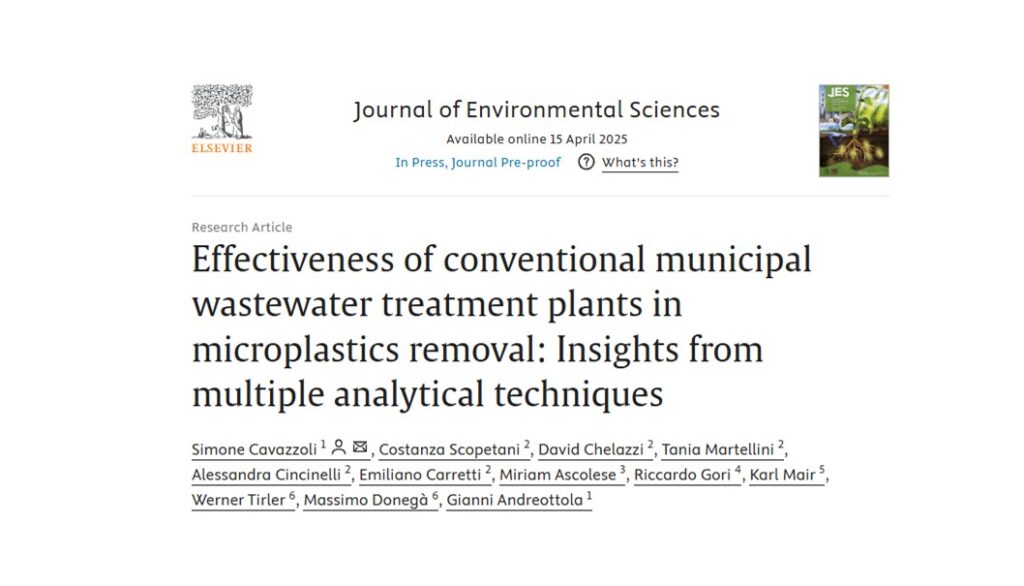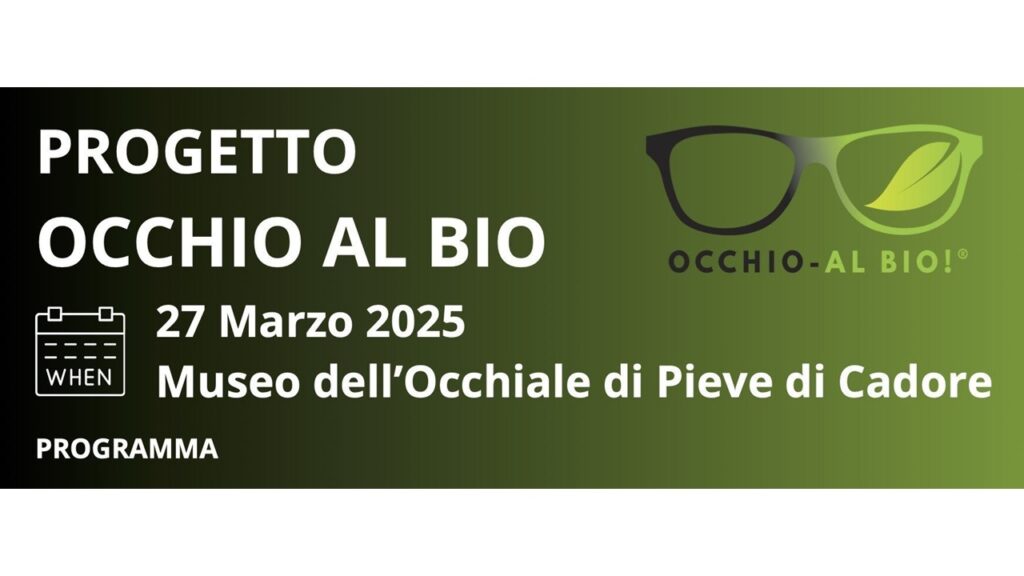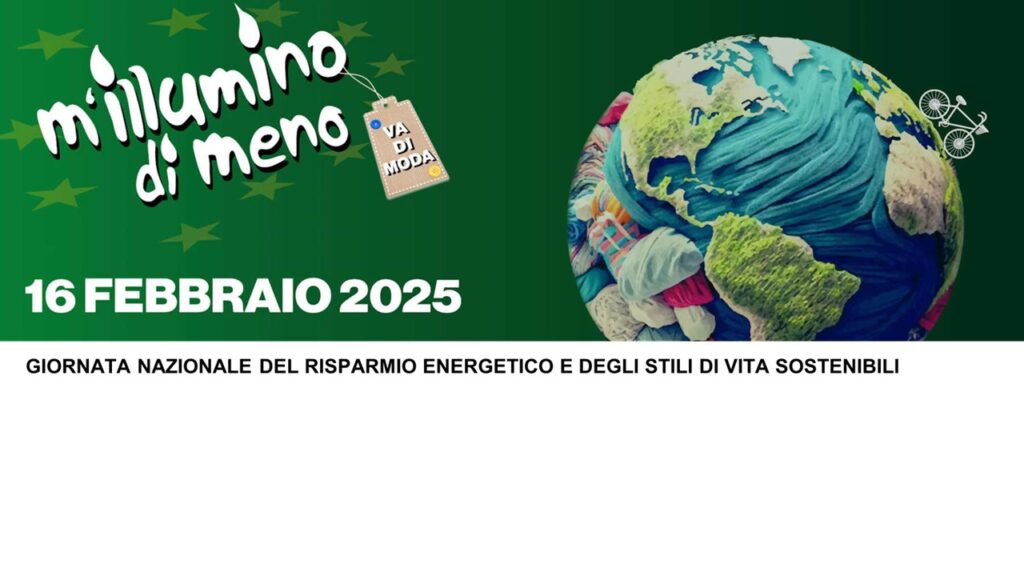Microplastic Removal from Urban Wastewater: A Study on the Efficiency of Treatment Plants

Global plastic production has increased significantly in recent decades, leading to growing concerns about plastic waste. One particularly urgent environmental issue is the spread of micro- and nano—plastic particles smaller than 5 mm that originate from the breakdown of plastic products or waste. In addition to posing risks to the environment and human health due to their persistence, these particles can also carry pathogens or release other pollutants. In urban settings, their presence in wastewater is primarily linked to domestic discharges and surface runoff. Since this water is treated in wastewater treatment plants (WWTPs), it is crucial to assess whether current treatment stages are sufficient to remove microplastics.
Bioplastics in Eyewear

On March 26, 2025, The Eyewear Museum in Pieve di Cadore hosted the closing event of the Occhio al BIO! project, promoted by Certottica Group in collaboration with the University of Trento and co-financed by the Cariverona Foundation. The project aimed to clarify the use of bioplastics in eyewear production, monitor development prospects in the sector, and provide companies with concrete tools to address the challenges related to innovation, sustainability, and waste management. It also examined the life cycle of eyewear and its treatment as waste. Since no specific disposal pathway exists for these products, the project explored potential solutions aligned with the principles of the circular economy.
M’illumino di meno 2025: a moment of reflection on plastic and fast fashion

Every year, on the occasion of the National Day of Energy Saving and Sustainable Lifestyles (M’illumino di meno, February 16), citizens, schools, institutions and associations are invited to take concrete actions towards sustainability. It is both a symbolic and practical opportunity to reflect together on how everyday choices contribute to a more responsible and environmentally friendly future.
SiD – Science in Depth: an innovative educational project

In today’s fast-paced world, developing deep knowledge and meaningful learning is a growing challenge. Guided by experts in STEM education, around 500 lower secondary school students from IC Bolzano V “Archimede,” IC Bolzano II “Ada Negri,” IC Laives “F. Filzi,” and IC Bolzano VI “Ugo Foscolo” will dedicate an entire school year to exploring a STEM-related theme.
This project offers a creative, multidisciplinary, and engaging journey, introducing new stimuli into school life to sharpen digital literacy, strengthen research and critical thinking skills, and deepen understanding in STEM subjects.
The ultimate goal is to help young people develop transversal skills through the scientific method — skills they can apply across different contexts — equipping them with the tools to understand and interpret the complexities of today’s world. In doing so, the project contributes to shaping aware, responsible citizens who observe their surroundings with a critical and thoughtful eye.
Nickel in Alpine Rivers Increasing Due to Cryosphere Degradation

Climate change not only reduces water reserves stored in glaciers and permafrost but may also contribute to the release of increasing amounts of solutes into high mountain rivers. Among these solutes, particular attention must be paid to heavy metals, such as nickel, which are abundant in certain rock types and are potentially toxic to aquatic organisms and human health.
The Chemical Fingerprint of Wood: Every Tree Reveals Its Origin

Where does the wood we use really come from? In a global context where the sustainable use of natural resources is increasingly urgent, answering this question is essential. Timber is a widely used raw material, and its illegal trade causes serious damage to ecosystems and biodiversity. Yet reliable tools to verify its geographical origin remain limited. A new study, conducted by Eco Research in collaboration with the Free University of Bozen-Bolzano, explores a concrete and effective solution: an approach that combines multi-element and isotopic analyses with advanced statistical models. The investigation focused on three typical tree species from the Eastern Alps – Norway spruce, European larch, and Swiss stone pine – grown on diverse bedrock types.
The results are promising: each species shows a distinctive chemical fingerprint, and the strontium isotopic ratio reliably reflects the geology of the growing area. This enables high-precision identification of both species and origin of each sample. The study opens new perspectives for the application of these techniques by regulatory authorities to verify timber origin, or by producers themselves to support certified supply chains.
Indoor air quality monitoring: results of the Torricelli–Eco Research project at Ecomondo 2024

Eco Research took part in the 2024 edition of Ecomondo in Rimini as co-author of an oral contribution within the session “Indoor air: its role in the relationship between environment and health”, organized by the Ecomondo Scientific Technical Committee & the Italian National Institute of Health, and moderated by Prof. Settimo (Italian National Institute of Health) and Prof. De Gennaro (University of Bari).
Conservation Soft Box: Study Results Presented in Rome in Collaboration with Eurac Research

At the annual meeting of the European Association of Archaeologists, held in Rome from 28 to 31 August 2024, the poster “The Conservation Soft Box (CSB): an innovative, efficient and low‐cost technique to preserve biological remains” was presented. The study was promoted by the Institute for Mummy Studies and the Institute for Renewable Energy of Eurac Research, with the participation of Eco Research.
Educational Collaborations for “Tomorrow’s Technicians”

The 2023/24 school year also concluded with a fruitful collaboration between Eco Research and the schools of Bolzano, aimed at training the “technicians of tomorrow”.
In particular, within the collaboration agreement with the “Galileo Galilei” Institute of Secondary Education, two internships of 76 hours each were conducted, one in September and one in October, with fifth-year students of the chemistry and environmental biotechnology course on the theme “Indoor Air Quality Analysis and Evaluation”…
The environmental challenge of the future: “Microplastic pollution”

The term “plastic” today encompasses thousands of products of various types. These cover a wide range of uses in everyday life and across the global population. Modern plastics exhibit vastly different characteristics from one another and are composed not only of the main polymer but also thousands of different molecules added to achieve the required properties for their use (plasticizers, colorants, softeners, flame retardants, etc.). The main characteristic of plastic is its durability over time, making it practically “eternal”: a plastic material product retains its characteristics and properties for decades, even when exposed to atmospheric agents. However, these agents have a significant abrasive effect and over time lead to the fragmentation of the polymer, resulting in “microplastics” (MPs). Microplastics have been found in every terrestrial environment, from the poles to glaciers, from surface soils to the deepest seas. To the extent that scientists worldwide now consider them one of the most significant environmental issues to address and resolve in the coming years…
